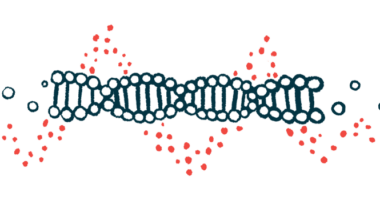Type of mutation in TTR gene found to influence FAP symptom profile
Researchers: Findings highlight importance of genetic testing in patients

The clinical symptoms of hereditary transthyretin amyloidosis (hATTR) — a group of disorders that includes familial amyloid polyneuropathy (FAP) — are highly influenced by the type of mutation in the TTR gene a patient has, a review study concludes.
The findings indicate that a clinical profile marked mainly by neurologic problems, as occurs in FAP, is most commonly associated with the Val30Met mutation and the formation and accumulation of toxic clumps of the full-length transthyretin (TTR) protein.
According to the researchers, the results highlight the importance of genetic testing, and of gaining a deeper understanding of the link between mutation type and clinical profile in hATTR to help “guide the subsequent diagnostic work-up and management” of the disease.
Further, the researchers noted that the findings may also inform “evidence-based recommendations for the follow-up and treatment of asymptomatic gene carriers,” which “remain a significant unmet need in hATTR.” Asymptomatic carriers are those carrying disease-causing mutations but not yet showing overt symptoms.
The review study, “Genotype-Phenotype Correlations in ATTR Amyloidosis: A Clinical Update,” was published in the journal Heart Failure Clinics.
Investigating the impact of each type of mutation in TTR gene
hATTR refers to a group of disorders caused by mutations in the TTR gene that lead to the formation of toxic clumps, called amyloid fibrils, that are made up of the transthyretin protein. These clumps, or aggregates, accumulate in the body’s tissues, disrupting their normal function.
FAP is a form of hATTR in which amyloid fibrils build up mostly in nerves outside the brain and spinal cord, leading to symptoms that are mainly neurological. When hATTR is marked mostly by heart damage and related symptoms, it’s called hATTR cardiomyopathy. With a combination of neurological and heart symptoms, it is classified as mixed.
More than 140 TTR mutations have been linked to hATTR, and a patient’s clinical profile “is largely influenced by the specific TTR [disease-causing] variant” the individual has. However, “significant differences among individuals with the same [genetic profile] have been observed,” the researchers wrote.
Moreover, “other factors such as geographic location, gender, or the genetic background seem to play a role in the clinical manifestations,” the team added.
As such, understanding the links between genetic and clinical profiles in hATTR is “crucial to facilitate early disease identification, predict adverse outcomes, and guide management with approved disease-modifying therapies,” the researchers wrote.
With this in mind, a team of researchers in Italy reviewed available data to date to describe what is currently known about the clinical profile of each of the three forms of hATTR, as well as its association with different mutations.
Regarding FAP, neurological symptoms typically develop in adulthood and manifest early as loss of sensation, nerve-related pain, and tingling sensations. Symptoms first affect the legs and extend to the hands and arms, resulting also in muscle weakness.
In some patients, damage to the autonomic nervous system, which controls involuntary bodily functions like breathing, heart rate, and digestion, is the main symptom and an early disease sign. This type of symptom often is used to distinguish FAP from other adult-onset progressive nerve disorders, the researchers noted.
Although the liver is the body’s main producer of TTR protein, it also is produced in a brain structure called the choroid plexus, meaning that toxic TTR clumps can also accumulate in the brain and spinal cord.
As a result, FAP patients may experience brief disturbances in motor, sensory, visual, or language functions, strokes, and cerebral amyloid angiopathy, a condition marked by fragile blood vessels in the brain due to the accumulation of abnormal proteins.
Val30Met mutation linked to 2 clinical profiles in FAP
FAP is predominantly associated with Val30Met, the most common TTR mutation. However, this mutation has been linked to two clinical profiles.
The early-onset profile — frequently seen in Japan, Portugal, and Sweden — primarily involves neurological symptoms. These include autonomic and gastrointestinal symptoms, as well as an abnormal heart rhythm, all of which typically present in the third or fourth decade of life.
The late-onset profile, with symptom onset after age 50, is marked by a mixed profile with neurological, heart, and eye involvement. The impact on the eyes is mainly due to transthyretin also being produced by several eye structures and layers.
Importantly, according to the researchers, the clinical presentation of people carrying Val30Met “seems to be influenced by the TTR fibril composition.”
Specifically, fibrils made of full-length transthyretin “are associated with early onset disease and no or mild [heart] involvement,” the team wrote. Meanwhile, “fragmented TTR fibrils are associated with late-onset disease” and a mixed clinical profile, they noted.
hATTR is a rare condition that exhibits a broad range of clinical [profiles] depending on the type of TTR gene variant. … [Understanding the links between the genetic and clinical profiles] can be valuable for early diagnosis, predicting the disease course, and guiding management.
Three other mutations associated with neurologic symptoms are Ile107Val, described in France; Gly83Arg, which is highly present among Chinese patients; and Leu58His, described in the U.S. among families of German descent, per the researchers.
Overall, this review highlights that “hATTR is a rare condition that exhibits a broad range of clinical [profiles] depending on the type of TTR gene variant,” the scientists wrote. Understanding the links between the genetic and clinical profiles “can be valuable for early diagnosis, predicting the disease course, and guiding management,” they concluded.








